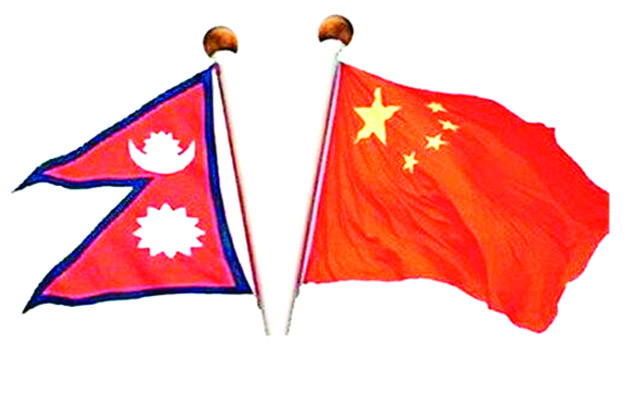Sino-Nepalese military confluence A conundrum for India in making?

By Colonel Satish Singh Lalotra
‘Our world has become a Neighbourhood without becoming a Brotherhood’—Billy Graham
Two major events in the recent past in our northern frontiers of the country viz Nepal have cast an ominous shadow on the Geo-politics of this sub-continent. Firstly was the vociferous and vehement chanting by the general public of this former Hindu monarchy with a slogan like-‘Come back king, save the country. Long live our beloved king. We want a monarchy’ at a rally in the month of March this year at Kathmandu. And second was the back to back visits of deputy head of the CCP’s (Chinese communist party) international liaison department Sun Haiyan, a political delegation in January 2024 , followed in quick succession on March 09 by a Chinese military delegation led by their Major General Zhang Baoqun . Both of these events have different connotations for a country like India who has locked its horns with both of these countries on an ideological as well as realpolitik plane. Sixteen years ago, mass protests in Nepal forced the then king Gyanendra Shah to give up the throne and clear the way for a republic. Now, a new wave of protest is trying to bring him back. The capital of this erstwhile Himalayan kingdom is again teeming with thousands of demonstrators, this time demanding that the king be reinstated as a king and Hinduism be brought back as a state religion. Royalist groups accuse the country’s major political parties of corruption and failed governance saying that people are frustrated with politicians. Mr Gyanendra Shah, the king was a constitutional head of the state without executive or political powers until 2005, when he seized absolute power. He disbanded the government and parliament, jailed the politicians, declaring a state of emergency by promulgating the army rule.
Are the so called vociferous demonstrations that rose firstly in November 2023 in support of the former king, and have now gained traction this year going to help India in case these protests convert themselves to a regime change? If yes, then in what manner and how much? What have been the past histories of both India and Nepal in patching up their differences with the latter under a monarchy during those times? Have we been better off since 2005/06 (when the monarchy ended) in cozying up to our northern neighbour and calling the shots too? Or are we doddering our way forward in our bilateral interactions with the former monarchy? These are some of the questions that should set our policy planners at Raisina hill ticking their minds. As stated above in my article, the Chinese military delegation’s arrival in Nepal, touring various Nepalese military institutions and holding discussions with the Nepalese army chief General Prabhu Ram sharma on various occasions showed the growing bonhomie and repartee between the two nations. These consecutive visits led by firstly their CCP reps and then the military delegation to Nepal presents a very complex scenario for our country.
The visits and the public statements of Chinese leaders in Kathmandu seem to project a durable China-Nepal relationship. However scratch the surface and you will find a growing unease of Chinese leaders, with increasing improvement of India’s relations with the former monarchy. It has spurred Chinese leaders to intensify their efforts to woo Nepal’s political and military elite. The aim of my article is primarily to explore and focus on this delegation’s proposals while evaluating China’s predicament and India’s prospects in Nepal when seen in conjunction with a possible regime change in the former monarchy. China’s military relations with Nepal have historically been among the weakest compared to its other south Asian neighbours, despite significant political , economic and social engagements over recent decades. This peculiarity has manifested due to so called ‘Structural factors’ with the military factor being the single biggest one. During the initial decades of China’s Cultural Revolution that culminated in its metamorphosis from a nationalist country being led by its Generalissimo Chiang -ki- Sheik to that of an absolutist country prophesizing a single line of thought as propounded by Mao -T se -Tung ; military connections between the two countries were minimal . And rightly so, since how could a monarchy following a Hindutva line of thought be co-terminus with an absolutist line of thinking of its northern neighbour? As the commander -in -chief of RNA (Royal Nepalese army) the Nepalese monarch addressed most military issues raised by the Chinese.
However ,Nepal’s transition to a republic in 2008 as mentioned by me in this write up above backed up by anti-China protests preceding the Beijing Olympics , prompted China to diversify and strengthen its political and military engagements with Nepal. Moreover these engagements primarily relied upon Nepal’s military capabilities for UN Peace keeping, disaster management, and internal security that were facilitated by grants, training, infrastructure development and joint exercises. Despite these Chinese efforts, a lingering hesitation persists in their bi-lateral military interactions due to Nepal’s enduring & special military ties with India. These ties , characterized by the famous ‘1950 Indo-Nepal treaty of friendship’ signed between the Indian ambassador to Nepal Chandereshwar Narayan singh and the last Rana of Nepal their prime minister Mohan shumsher jang Bhadur Ran has been the single biggest road block in China establishing an equally influential military partnership with Nepal. But fortuitously for China due to our (read Indian) follies this seminal treaty is under the strain of getting snapped with ominous consequences for us. The Indian army’s so called ‘Agniveer recruitment ‘policy is one of the biggest dampeners towards weakening the present Indo-Nepal treaty of 1950. Where are the quint essential Gurkhas in this entire gamut of things? Obviously left out. Why did the top brass of Indian policy makers did not apply their minds to have that window of opportunity in this so called new recruitment policy for a Gurkha to slip into? This lost opportunity if media circles are to be believed in, is being lapped up by the PLA to offer an olive branch to these Gurkhas to become one among them. The point to be noted over here is that the Gurkhas who became part and parcel of the Royal Indian army in the middle of 19th century were mentally attuned to be part of the sub-continent’s military arm after the famous ‘1816 treaty of Siguali’ that was signed after the defeat of Nepal at the hands of East India company of England. How could centuries of military ties between the two neighbouring countries be given a go by in such a perfunctory manner by India?
Coming back to the strained China -Nepal ties that were further put under a fresh onslaught of pressure in the recent past. The pandemic of Covid -19 prompted China to close its doors (read borders) during 2020 -2023 and suspended all military engagements impeding material and personnel exchanges until mid-2023. Consequently, this unofficial blockade significantly impacted mutual trust, underscoring the fragility of military ties amidst broader geo-political dynamics. Following the relaxation of the covid-19 restrictions few months back in 2023, a Chinese military delegation led by their Major General Yue Ande from the PLA’s Tibet military command visited Nepal on 16 th August 2023. During this visit, agreements were reached to revive the so called ‘Sagarmatha’ joint military exercise series, and multiple seats were offered for Nepal army officers in Chinese military training academies. China also offered 4 seats in the annual defence and strategic studies course at China’s college of defence studies (CDS). The Zhang Baoqun military delegation is the second one in recent months with an avowed aim to bolster the sagging Sino-Nepalese military ties. The delegation also had a hidden agenda to advance the deal of armoured personnel carriers ( APC) procurement contract , proposing the installation of an ammunition plant and resuming the ‘Sagarmatha’ joint military exercises etc as part of on an overall increased Chinese military visibility in the erstwhile Hindu kingdom.
To an uninitiated in the military affairs of this sub-continent, at first glance Zhang’s proposals appear quite harmless, ostensibly to rejuvenate the military camaraderie between China & Nepal. But scratch the surface and out tumbles the Chinese game plan to have an increased foot print in Nepal potentially at India’s expense. Moreover it has been often observed that in this entire Sino-Nepalese bonhomie, the Chinese are leaving no stone unturned in giving a heft to their late leader Mao Tse Tung’s philosophy of claiming Nepal as one of its fingers with the palm resting at Tibet. In an increased effort to close the pincer of their big game plan, the Chinese have been lobbying hard to get the deal of 26 APC’s get going that had stalled since the past few years. The NA (Nepal army) finally decided to buy them from a US- blacklisted Chinese manufacturer NORINCO (North industries Group Corporation limited) rejecting cheaper Indian bids. In 2023, accusations of corruption and price inflation emerged, leading to the current PM of Nepal freezing the contract. Be that as it may, the Nepalese army is adamant about the decision based on its historical ties with the manufacturer. What about decades of old Indo-Nepal ties in this regard? How come they have been short shrifted at the expense of Chinese NORINCO? In the similar vein, up till 2022 Chinese manufacturers were the preferred ammunition suppliers to Nepal after it switched from its southern neighbour. However the quality of Chinese ammunition has been subpar leading Nepal to look again towards India’s side and thence the same ammunition was procured from an Indian company ‘SSS Defence’. This Indian company outbid Chinese company in an open bidding contract. Now this is where Gen Zhang’s delegation comes into play wherein he has held a carrot in front of Nepal to install an ammunition plant itself In the Himalayan nation, thereby undermining Indian re-entry into the Nepalese army’s ammunition inventory. In fact China has not let its guard down to re-start the ‘Sagarmatha’exercise that had gone into hibernation since 2019 but without any success.
In the light of the above revelations some very pertinent questions arise that seem to be asking an urgent resolution from the policy makers siting at Raisina hills-
* What measures have been taken by the Govt of the day to wean back the only Hindu nation of Himalayas back from the Chinese influence into the lap of India?
* How much support should India afford to the pro -Royalists of Nepal for a regime change given the fact that past ties reveal a pro-India stance of Nepalese Royals towards our country?
* Why despite so much of clamouring in favour of giving the Gurkha recruitment a chance in the Agniveer programme nothing tangible has emerged?
* What damage control can India afford in the backdrop of Gurkha recruitment fiasco in the Agniveer recruitment policy?
* Since Nepal is a ‘Subsistence based’ economy , has India proportionately increased Nepalese recruitment in its central govt sponsored schemes to off-set the loss of Gurkha recruitment in its armed forces thereby maintaining an equanimity of foreign relations ?
* In the backdrop of the military standoff between the two Asian giants all along the Mac -Mohan line doesn’t it make sense for India to shed its big- brotherly attitude towards Nepal and bring it back to its fold thus securing a sliver of land along its northern frontiers ( read Nepal) thereby reducing that much of heightened tensions ?
It is abundantly clear from the above that India has somehow been undercounting its efforts in making its presence felt as the dominant power in south Asia, more so in the Himalayan nation of Nepal. Seems the country has to go back to the drawing board of 1950/60s when the bonhomie between the two Hindu nations was at its peak to ward off any intrusive efforts of an outside power (read China) . The sooner the better.




